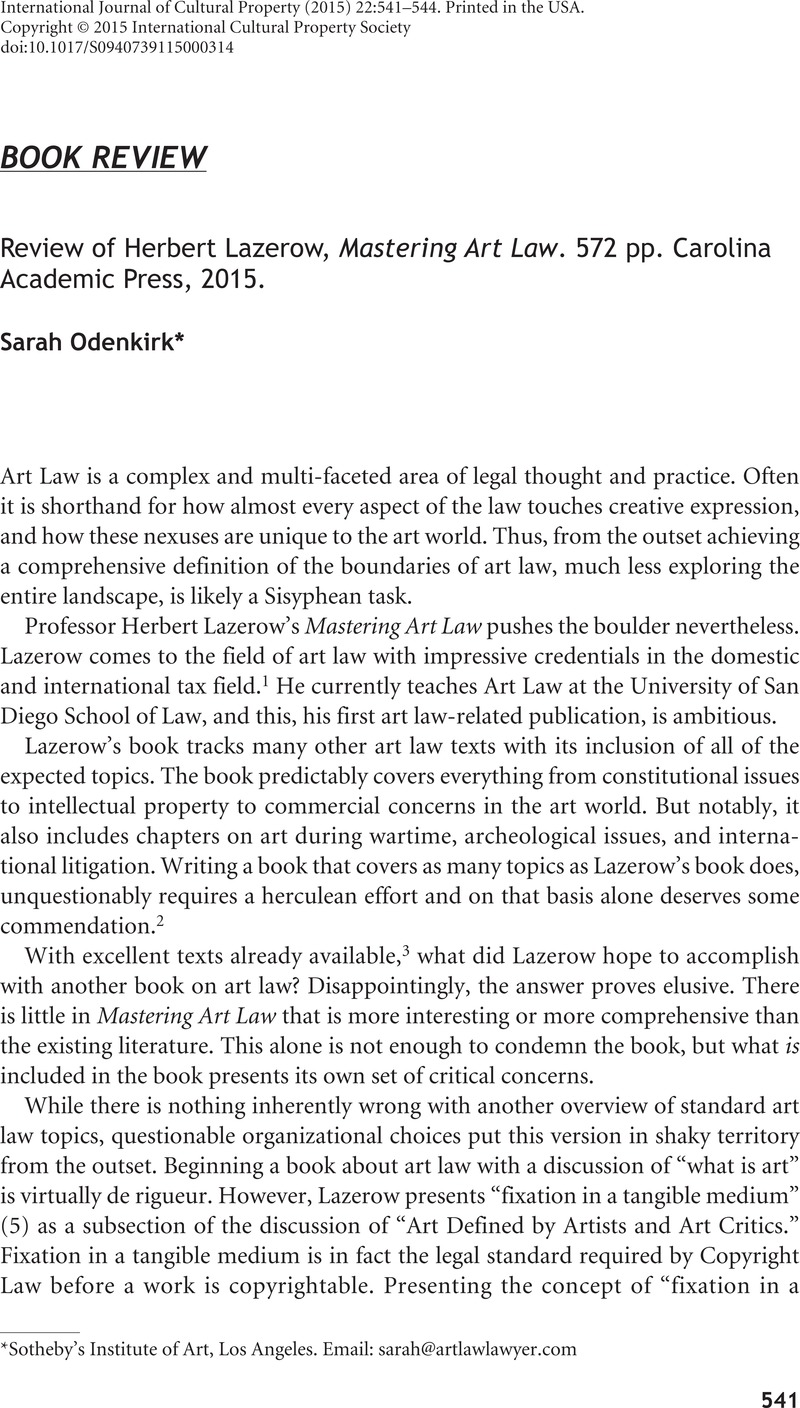Article contents
Review of Herbert Lazerow, Mastering Art Law. 572 pp. Carolina Academic Press, 2015.
Published online by Cambridge University Press: 08 December 2015
Abstract

- Type
- Book Review
- Information
- Copyright
- Copyright © International Cultural Property Society 2015
References
ENDNOTES
1 Professor Lazerow graduated from the University of Pennsylvania in 1960, received his law degree from Harvard University in 1963, an LLM from George Washington University in 1964, and earned a DESS in 1982 from the University of Paris I. Professor Lazerow was a legal writing teaching fellow at George Washington University and spent two years drafting regulations, legislation and tax treaties with the U.S. Internal Revenue Service’s Chief Counsel’s Office. He taught at the University of Louisville and was a visiting professor at the Université de Paris X Nanterre and the University of California, Berkeley School of Law. He joined the University of San Diego School of Law faculty in 1967. He has written extensively about tax law in particular. This information and more can be found at https://www.sandiego.edu/law/faculty/profiles/bio.php?ID=708.
2 The book is also more reasonably priced than many other comprehensive art law books available, making it more realistically accessible to readers interested in art law.
3 To name just a few, see for example: the comprehensive two-volume series compiled by Judith Bresler and Ralph Lerner, Art Law: The Guide for Collectors, Investors, Dealers & Artists (2012); Judith Prowda’s Visual Arts and the Law: A Handbook for Professionals (2013); Roy S. Kaufman’s Art Law Handbook (2000); John Merryman, Stephen K. Urice, and Albert E. Elsen’s Law, Ethics and the Visual Arts (2007); and Alexandra Darraby’s Art, Artifact, Architecture and Museum Law (2014).
4 See Lazerow, 226–36.
5 Examples of information that is conflated or incomplete to the point of misleading are too abundant to list in this limited review. One such example is the discussion of “Not Stolen but Gifted,” ibid., 223. Lazerow’s comments on the Portrait of Wally case are hypothetical, not supported by the actual case, and without the full story, misleading to the reader.
6 This is in addition to his prior confusing statement in the Roadmap section at the beginning of the chapter, where he writes: “Transferring the work does not transfer the copyright unless such an intent is expressed.” His statement on the next page that “[t]he transfer of an exclusive right or an assignment can only be made in writing . . .” still does not adequately clear things up as it omits the requirement that the writing also be signed by the copyright owner.
7 This is actually the only point supported by the reference to 17 U.S.C. §202 following his sentence.
8 Lazerow, 86. Information about fractional shares of artwork is important and interesting, but exactly the sort of thing that should be included, or at least further explained, in a footnote so as not to distract from or confuse the subject of parsing or transferring copyright interests. Though perhaps cliché, summoning the oft-used analogy of a bundle of sticks in order to make the concept of parsing out pieces of intellectual rights more comprehensible is far more helpful.
9 See Lazerow, 132.
10 Where are the amazing stories behind some of the last 50 years’ most important art law cases? Why leave out descriptions of Robert Mapplethorpe’s BDSM art, the controversy around David Wojnarowicz’s “A Fire in My Belly” which included crucifixes covered in ants, or Andre Serrano’s “Piss Christ” depicting Jesus on a cross submerged in urine? What about Jeff Koons’ egomaniacal entitlement in the seminal string of puppies case (Rogers v. Koons) or the triumph of popular culture in the Acuff-Rose decision that followed? Richard Prince’s arrogant use of Patrick Cariou’s Rastafarian photos without attribution was so galling to the Circuit Court that it ordered the infringing artwork be destroyed! Why hide the drama?
11 See Lazerow, 375–76.
12 See ibid., 401–2, 406–7.
- 1
- Cited by


